Frank's travels around Britain 2010.
North Yorkshire Moors.
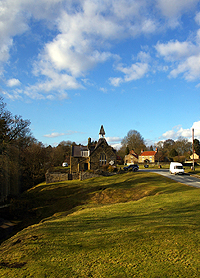
 After
all the snows & heavy rain, once again my lucky breaks came good. Four days
after
very heavy rain were followed by absolutely stunning weather. Clear, sunny, if a
little chilly. Why worry? Photographs only need sun & I can always wrap up warm.
After
all the snows & heavy rain, once again my lucky breaks came good. Four days
after
very heavy rain were followed by absolutely stunning weather. Clear, sunny, if a
little chilly. Why worry? Photographs only need sun & I can always wrap up warm.
I got myself an off season three day break, self catering in an inexpensive annexe in a house made up of three flats in the truly stunning village of Hutton Le Hole. Situated on the southern edge of the North York Moors National park near the town of Pickering. Hutton gives the impression it was designed by Walt Disney as a film set! Indeed, the village is classed as a "honey pot village", a real magnet for tourists, the Ryedale Folk museum doing its best to shed light on all the local history.
Hutton-le-Hole's name means the high farm near the hollow (Hole) but was formerly known as Heg Hoton - a heg being land enclosed for hunting. Le-Hole was added to Hutton-le-hole's name by the Norman French to distinguish Hutton from other northern Huttons of which there are many.
The village is split by the peat brown water of the beck running down through
the village. Beautifully clear but so lifeless. No plants, no fish, just clear
running water The wide centre area between the rows of cottages is just
undulating grass, a
few trees & many sheep. I can imagine the place packed i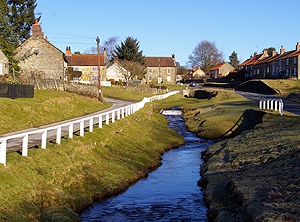 n the summer with
ice cream eating, picnicing tourists all clicking away with their cameras. On each
side of the green the rows of cottages are all white painted doors & window
frames with red pan tiled roofs, many of them holiday homes. The excellent
museum, caravan club camp site, church, gift shops & cafe are on your left as you walk down the village. Of course, out
of season many things were closed but the Crown Pub & the museum provided
somewhere to go, even in very early march. Out of season it is wonderfully
quiet, even though I discovered a teenage lovebird message, drawn by finger on
my filthy rear window to some girl called Elaine, there was just silence for
hours. Rowdy teenagers don't see to be in evidence at all.
n the summer with
ice cream eating, picnicing tourists all clicking away with their cameras. On each
side of the green the rows of cottages are all white painted doors & window
frames with red pan tiled roofs, many of them holiday homes. The excellent
museum, caravan club camp site, church, gift shops & cafe are on your left as you walk down the village. Of course, out
of season many things were closed but the Crown Pub & the museum provided
somewhere to go, even in very early march. Out of season it is wonderfully
quiet, even though I discovered a teenage lovebird message, drawn by finger on
my filthy rear window to some girl called Elaine, there was just silence for
hours. Rowdy teenagers don't see to be in evidence at all.
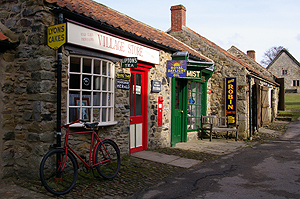 I can recommend the museum.
There are 13 historic buildings showing the lives of ordinary folk from earliest
times to the present day. It's all set in 3 acres. There are rescued and
reconstructed historic buildings including, shops, thatched cruck
cottages, Elizabethan manor house, an iron aged round house, barns and workshops. The museum records the
daily life of North Yorkshire people from the earliest inhabitants to 1953.
There are the tiniest of Neolithic flints, the magnificent cruck timbers from
the 16" century and the splendid 1850's Merryweather fire engine. There is the
oldest daylight photographic studio in the country, and the renowned Hayes
collection of photographs. The witch post in Stang end cottage is
I can recommend the museum.
There are 13 historic buildings showing the lives of ordinary folk from earliest
times to the present day. It's all set in 3 acres. There are rescued and
reconstructed historic buildings including, shops, thatched cruck
cottages, Elizabethan manor house, an iron aged round house, barns and workshops. The museum records the
daily life of North Yorkshire people from the earliest inhabitants to 1953.
There are the tiniest of Neolithic flints, the magnificent cruck timbers from
the 16" century and the splendid 1850's Merryweather fire engine. There is the
oldest daylight photographic studio in the country, and the renowned Hayes
collection of photographs. The witch post in Stang end cottage is
 one of only 20
known examples and all coming from Yorkshire apart from just one in Lancashire.
There is a comprehensive collection of working craft tools and domestic cookery
equipment. Of course, being out of season, volunteers were building a new model
village. It seemed to be taking shape well in time for the season to begin at
Easter. The museum normally hosts a series of special days and events throughout
the year, including, craft demonstrations, rare breeds of farm livestock, engine
days, working cottage life & all its country equipment is laid out for you to
explore & absorb.
one of only 20
known examples and all coming from Yorkshire apart from just one in Lancashire.
There is a comprehensive collection of working craft tools and domestic cookery
equipment. Of course, being out of season, volunteers were building a new model
village. It seemed to be taking shape well in time for the season to begin at
Easter. The museum normally hosts a series of special days and events throughout
the year, including, craft demonstrations, rare breeds of farm livestock, engine
days, working cottage life & all its country equipment is laid out for you to
explore & absorb.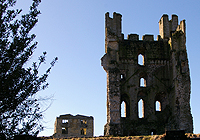
I went back West along the road to Helmsley, a tiny market town with a castle at its centre. There's a very big car park & its all very attractive but unless you shop or need a coffee, its just an attractive town to pause in. It had four former coaching inns and a half timbered rectory. Helmsley hasn't always been such a peaceful backwater. At the height of its prosperity as a weaving centre in the seventeenth century, the loom operators were famous for their thirsts, their songs and their leather breeches" and historic accounts of the local fair suggest an event which was fraught with fist-fights and drunkenness. The skyline is dominated by its castle ruins, which date back to around the year 1200. Like so many Royalist strongholds, it was blown up by the Parliamentarians in the Civil War to prevent it from being used again.
 On the way across towards Pickering, normal traffic use the Sutton Bank, a steep
heavily curved part of the A170 road that climbs up to the North York Moors. Caravans & HGV vehicles are forbidden as many came to grief trying to conquer it over the
years. I knew the views where spectacular as far as York, so I parked up
on the car park near the edge & went to take my photos. Of course the sunny
weather produced a haze & it was good but as they say ... not that good. Out of
season or not, many people were enjoying the views in the bright but chilly
sunshine. Walking along the edge brings you to the Yorkshire Gliding club & somewhat further on is
the Kilburn White Horse. It was created by the local schoolmaster in 1857 who
got his pupils to mark it out, and then locals came along and cut out the turf.
I have never been in a position to view it & only recently found there was a
white horse so close.
On the way across towards Pickering, normal traffic use the Sutton Bank, a steep
heavily curved part of the A170 road that climbs up to the North York Moors. Caravans & HGV vehicles are forbidden as many came to grief trying to conquer it over the
years. I knew the views where spectacular as far as York, so I parked up
on the car park near the edge & went to take my photos. Of course the sunny
weather produced a haze & it was good but as they say ... not that good. Out of
season or not, many people were enjoying the views in the bright but chilly
sunshine. Walking along the edge brings you to the Yorkshire Gliding club & somewhat further on is
the Kilburn White Horse. It was created by the local schoolmaster in 1857 who
got his pupils to mark it out, and then locals came along and cut out the turf.
I have never been in a position to view it & only recently found there was a
white horse so close.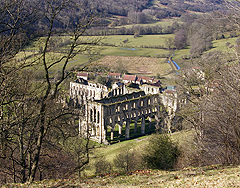
Deep in the country side, lies the stunning, if modest Cistercian Abbey of Rievaulx (pronounced Ree-voh). Of course, as I gathered over the days, it was closed! It was once one of the wealthiest abbey's in England and was dissolved by Henry VIII in 1538. Founded in 1132 by twelve monks from Clairvaux Abbey as a mission centre for the colonisation of the north of England and Scotland. It was the first Cistercian abbey in the north. The remote location was ideal for the Cistercians, whose desire was to follow a strict life of prayer and self-sufficiency with as little contact as possible with the outside world. (Maybe that's why all over the area, mobile phones don't work!) . In the 1750s Thomas Duncombe III beautified the estate by building the terrace with two Grecian-style temples; these temples, now called Rievaulx Terrace & Temples, this is a wonderful place to view the Abbey. The cost of visiting both places (one owned by English Heritage & the other by The National Trust) will soon empty your pockets. For what an opinion is worth, the best photographs are from the terrace. Its highly recommended.
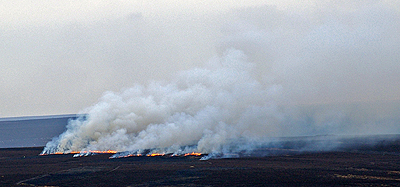 I
decided I'd like to cross the wild moors on my way to see Whitby & the coast. In
early March, even on a sunny day, wild is the word. This isn't the prettiest
of places, there are nice remote villages like Goathland (famous for its
connection to the TV series "Heartbeat") to pass
through but on the whole its steep drops, stiff climbs, pot holes to make a
Yaris shudder & many small fords. I think it must be magical to see the heather
when its out & there will be places I never touched. I feel sure that another
visit is due in a the late summer season, if only to see the place a mass of
purple heather. This was the season for burning & all over there were plumes of
smoke rising as controlled burning was taking place.
I
decided I'd like to cross the wild moors on my way to see Whitby & the coast. In
early March, even on a sunny day, wild is the word. This isn't the prettiest
of places, there are nice remote villages like Goathland (famous for its
connection to the TV series "Heartbeat") to pass
through but on the whole its steep drops, stiff climbs, pot holes to make a
Yaris shudder & many small fords. I think it must be magical to see the heather
when its out & there will be places I never touched. I feel sure that another
visit is due in a the late summer season, if only to see the place a mass of
purple heather. This was the season for burning & all over there were plumes of
smoke rising as controlled burning was taking place.
A very pleasant cafe in Rosedale Abbey was a nice break. Cakes to die for! The name came from a Cistercian Priory that once stood on the site. All that is left today is a stair case, sundial and single stone pillar. Originally founded in 1158 the priory was inhabited by a small group of nuns who are credited to be the first people to farm sheep commercially in the region. The priory ceased to operate in 1535 due to the Dissolution of the Monasteries. The building was eventually dismantled in the 19th century when the stone was reclaimed for building including a new church of the site of the original priory.
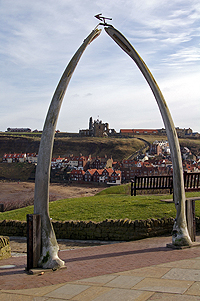 Whitby was a strange place. Whitby was founded under its Old English name of
Streonshal in 656, when Oswy, the Christian king of Northumbria, founded Whitby
Abbey, under its first abbess Hilda. The Synod of Whitby was held here in 664.
In 867, the monastery was destroyed by Viking raiders, and was only refounded in
1078. It was in this period that the town gained its current name, Whitby, (from
"white settlement" in Old Norse). In the 18th century Whitby became a centre for
shipbuilding and whaling, as well as trade in alum and jet.
Whitby was a strange place. Whitby was founded under its Old English name of
Streonshal in 656, when Oswy, the Christian king of Northumbria, founded Whitby
Abbey, under its first abbess Hilda. The Synod of Whitby was held here in 664.
In 867, the monastery was destroyed by Viking raiders, and was only refounded in
1078. It was in this period that the town gained its current name, Whitby, (from
"white settlement" in Old Norse). In the 18th century Whitby became a centre for
shipbuilding and whaling, as well as trade in alum and jet. 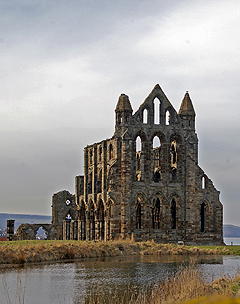
One unusual feature of Whitby is the Dracula Museum. Part of Bram Stoker's famous novel was set in Whitby, describing Dracula's arrival in Britain on a ship washed ashore in the harbour, and how Lucy watched from the churchyard as the sun set over the nearby headland of Kettleness, but did not know how many steps she climbed to get there. Stoker's story incorporated various pieces of Whitby folklore, including the beaching of the Russian ship Dmitri, which became the basis of Demeter in the book. Furthermore, it was at the public library in Whitby that Stoker discovered the name "Dracula."
West Cliff side has its own landmarks — a statue of Captain James Cook, who served his apprenticeship in the town, and a whalebone arch, commemorating the once large whaling industry.
Apart from the fact it was closed, Whitby Abbey has a unique feature .... you find it very hard to photograph it! (at least I did!) It has the huge church of St. Mary's in front of it, a large wall surrounding it. The Abbey is on the East Cliff side of Whitby and it is quite a distance by road, the alternative way to get there was by climbing the 199 steps of the "Church Stairs" or to use a footpath called Caedmon's Trod.
Before travelling back across those moors, I tried to see Robin Hoods Bay, a famous beauty spot. Of course .... it was closed! Men repairing footpaths, Cafe NOT serving food & not a shop open!
Hutton Le Hole is fabulous, the moors will be stunning in late summer & I suspect that there are many more places to visit. I have no doubt that I'll be back!
Links for
information on this page:
A 360 degree view of Hutton Le Hole
